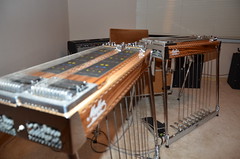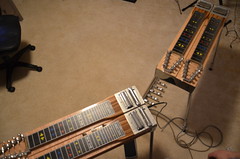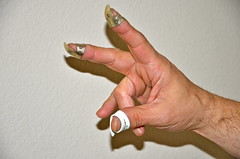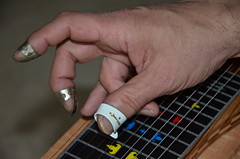Since starting my blog I have acquired some insight as to the direction I want to go based on my observations of what you the reader is looking for. This will be a learning experience for me as well. Read more and let me know what you think.
Thanks
This blog is about my love and passion for the pedal steel guitar. I will post discussions about the pedal steel guitar, copedants, learning styles, and my journey learning this instrument.
Thursday, January 31, 2013
Wednesday, January 30, 2013
C6 Kansas City Practice Continued
On Monday I spent 2 more hours and today I spent 1 hour practicing after my lesson bringing my total week to date to 9 hours. I also spent 5 minutes both yesterday and today on the violin. Cannot really call that practicing but I am keeping track. As always I start my practice going over my current lesson a couple of times then play the songs I already know. I then move back to my current lesson for the remainder of the night. I added a few more chords in learning Kansas City. My precision is improving as well as I am getting use to the C6 neck. My Fender amp volume knob is not functioning properly. Back to shop. Just got it out of the shop back in November having tubes changed and bias set.
I just had to add a pic of both of my zebra wood guitars. Both cut from the same piece of lumber but both have different tone even though they have the same setup. I also have included some pics of my violins as well. One is a circa 1890's - 1900 Hopf violin and the other is a cheap Chinese mad violin (if you call $1,000 cheap). Even though it is a Chinese violin it has a nice tone. Of course the Hopf is my favorite.
I just had to add a pic of both of my zebra wood guitars. Both cut from the same piece of lumber but both have different tone even though they have the same setup. I also have included some pics of my violins as well. One is a circa 1890's - 1900 Hopf violin and the other is a cheap Chinese mad violin (if you call $1,000 cheap). Even though it is a Chinese violin it has a nice tone. Of course the Hopf is my favorite.
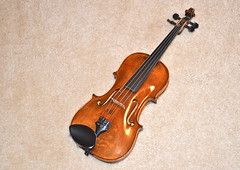 |
| My Hopf |
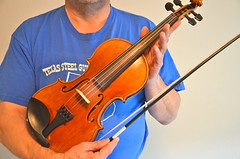 |
| My second violin |
Sunday, January 27, 2013
C6 Kansas City Continued
Well It is Sunday and the start to a new week. I only got 8 hours of practice last week. I lost 5 hours yesterday as I was down with a touch of food poisoning. So today I will try and make up some time. I got about 2 hours practice in before my lesson. My right hand finger position is getting better. I am not fumbling around to find my string chord positions like I was on Friday. I am successfully keeping my right hand over the pickups as I practice. I am also able to keep my pinky on my left hand down on the strings as I use the tone bar. So my little victories over some bad habits. When I leave my lesson, I turn off the radio and drive home with only the lesson playing in my head. When I get home I immediately set up in my music room and go over my lesson a couple of times before I get dinner which is usually waiting for me. After dinner, I go up and practtice. Tonight I practiced for 1 hour giving me a total of 4 hours so far for the week. I have practiced all the songs I have learned and relearned 7 in all then also practice my current lesson. Remember my discussion in a previous post about Together Again? That bar slanting technique that will take me 10 years to perfect? Well I am continuing to practice that small part daily as well.
I did do it! I took my violin and had my instructor tune it for me and I am just going to practice pulling the bow across the strings. I am not going to worry about finger positions until next week. If it gets to be too much I will put it down for a while. I did not realize how much I missed learning the violin. I must be a glutton for pain! LOL. After I finished practicing on my steel guitar I spent about 5 minutes practicing on the violin. My short practice was successful as I drew the bow across all the strings without the screech. However, I was not able to cleanly draw across the D and A strings as I kept getting the G and E strings and I was sometimes getting a harmonic.
The techinques I am using in the song Kansas City include:
1. Single string picking and slide
2. Forward roll
3. 3 string chord picking with palm blocking.
I am still focusing on precision. Is the bar where I think it is? If not start over and try again. Is the roll timed well from the slide where it sounds like a single chord? Is the timing between chord picking correct? Is my left hand staying where it needs to be. Is my left hand where it needs to be and am I holding the tone bar correctly.
My lesson tonight was good. Learned the next few chords to Kansas City on the C6 neck. Taking me right into second octave right from the start. No pedals or levers yet. This is good as it is giving me time to acclimate to the C6 neck. I have 3 center levers dedicated to the C6 neck, I have to adjust my seated position so my left knee is between these levers. These levers are situated approximately between the 7th and 12th frets. This new position changes my perspective on the bar illusion and seems to make it easier to be more precise.
I have tonight and tomorrow after work to practice this new phrase and smooth it out before my next lesson. Posting on a regular basis is helping me keep track of my practice time and gives me a reference back on problem areas and when discourage can read about my own progress. I will post again Tuesday evening after my lesson.
I did do it! I took my violin and had my instructor tune it for me and I am just going to practice pulling the bow across the strings. I am not going to worry about finger positions until next week. If it gets to be too much I will put it down for a while. I did not realize how much I missed learning the violin. I must be a glutton for pain! LOL. After I finished practicing on my steel guitar I spent about 5 minutes practicing on the violin. My short practice was successful as I drew the bow across all the strings without the screech. However, I was not able to cleanly draw across the D and A strings as I kept getting the G and E strings and I was sometimes getting a harmonic.
The techinques I am using in the song Kansas City include:
1. Single string picking and slide
2. Forward roll
3. 3 string chord picking with palm blocking.
I am still focusing on precision. Is the bar where I think it is? If not start over and try again. Is the roll timed well from the slide where it sounds like a single chord? Is the timing between chord picking correct? Is my left hand staying where it needs to be. Is my left hand where it needs to be and am I holding the tone bar correctly.
My lesson tonight was good. Learned the next few chords to Kansas City on the C6 neck. Taking me right into second octave right from the start. No pedals or levers yet. This is good as it is giving me time to acclimate to the C6 neck. I have 3 center levers dedicated to the C6 neck, I have to adjust my seated position so my left knee is between these levers. These levers are situated approximately between the 7th and 12th frets. This new position changes my perspective on the bar illusion and seems to make it easier to be more precise.
I have tonight and tomorrow after work to practice this new phrase and smooth it out before my next lesson. Posting on a regular basis is helping me keep track of my practice time and gives me a reference back on problem areas and when discourage can read about my own progress. I will post again Tuesday evening after my lesson.
My First C6 song Kansas City
In the beginning, I told you that for the first few years you would probably be concentrating on the E9 neck. During the 38 months I have been learning to play the pedal steel guitar, I have learned all my songs on the E9 neck. There have been a couple of exercises on the C6 and a brief attempt at learning Walking After Midnight on the C6 neck. After finishing learning The Last Date, my instructor surprised me by starting to teach me To Kansas City on the C6 neck. The first noticeable transition from the E9 to C6 neck is that pesky optical illusion. Also I am having to relearn my picking hand position. I initially am having difficulty locating my chord combos 3-4-5, 4-5-6, 5-6-8 and 6-8-10. I am fumbling around for them or picking the wrong string entirely. This will go away in short order the more I practice and get use to being on C6. The tone bar optical illusion is not as dramatic for me but I can still see and feel it. I include this little ramble for the benefit of both students and instructors. As an instructor, if you hear the problems I as a rookie have (however minor they are), then you can bet other students experience the same or similar problems. While this is a minor issue which will go away with practice, it is still annoying to me. My best advice to an instructor is be patient with us. I know I am not going to set Nashville on blaze any time soon, however, I am better than I was when I started. My tendency is to be more harsh on myself than my instructor is. My instructor keeps reminding me to relax and have fun with it and don't put needless pressure on yourself. This helps and I must always remind myself of this. If your instructor my hat is off to you to have the patience for a beginner. To students of this instrument you must:
1. Practice religiously
2. Have patience
3. Pay attention to the little details
4. Do not be to harsh on yoursel. Be critical, yes, but don't over do it.
5. When you are not practicing or playing then listen to steel guitar music
6. Work on technique -- rolls forward and backward, harmonics palm and finger, sustain, precision
Remember success comes in baby steps. All the little details do not look like much, yet when you combine them all they make all the difference in the world. If you are a guitarist transitioning to the steel guitar you will need to overcome your natural tendency to pick every note. IMHO violin players would find the transition to the steel guitar easier than most. About a year ago, I convinced my instructor to start teaching me violin. The first lesson was obviously how to hold the violin and bow and how to draw the bow across the strings both downward and upward with the proper rotation of the bow. I went home and practiced. A few times during practice I would achieve the classic screech of all beginners. By the time I went back to my next lesson and demonstrated to my instructor the lesson I had learned, I was able to go through the lesson without the infamous screech. I then asked my instructor if the infamous screech was urban legend or just blown out of proportion. He laughed and said no it is very common. Of course that made me feel good about what I had learned but led to my next question. Why am I not having the same problem. The answer was that I had been playing the steel guitar for two years and the bar is to the steel guitar what the bow is to the violin. You have the relationship intuitively and it is easier. I thought wow, I do not consider myself a gifted musician by any stretch of the imagination yet I am able to accomplish something so simple in a very short time. Just think what an experienced violin player could accomplish coming to the steel guitar. My instructor thought highly enough of my potential or dedication or both that he sold me one of his violins. It is a Hoff circa 1890 to early 1900's. A previous owner had taken the finish off the violin and it looked awful. Yet when my instructor played it the sound was beautiful. I took the violin to Bischofberger in Seattle WA bviolins.com and met Kenny who told me he could do the work and it would take 6 months or so. I agreed and 8 months later it was done. In the mean time, I was not going to wait that long so I went to Ted Brown Music Co http://www.tedbrownmusic.com/ in Tacoma and bought a violin and two new cases. Now, I was taking steel guitar lessons and violin lessons 3 times a week. By the time, I could play twinkle twinkle little star on the violin, it became very clear to me I would not be able to keep this pace up of lessons and the time to practice and maintain normal life duties and responsibilities. Sadly, I decided to postpone my violin lessons for now and pick it up later. The reason I include this little story is I am beginning to get the cravings to start with the violin again. If I do, I do not think I will try and be as aggressive with it as I was before. The big advantage to learning the violin for me was it was training my ear. Also, I think this is a nice match between instruments and players of either instrument would benefit learning the other.
Here are some pics of both violins.
Back to the steel guitar and my current lessons. One of the techniques I am starting to learn bar shivers. Bar shivers is where you pick a note, let it ring and as you slide down to your next fret, vigorously over emphasize a vibrato as you slide down. The difference between vibrato and shivers is the range of movement used to achieve the effect. Many steel players use shivers like vibrato and overuse it.
Well thats it for now. Today is Sunday 27 JAN 2013 and I have a lesson today. I will write another post this evening about my lesson. I am going to try and keep up my posts 3 times a week to match my lesson schedule otherwise I will forget details to include in my posts.
1. Practice religiously
2. Have patience
3. Pay attention to the little details
4. Do not be to harsh on yoursel. Be critical, yes, but don't over do it.
5. When you are not practicing or playing then listen to steel guitar music
6. Work on technique -- rolls forward and backward, harmonics palm and finger, sustain, precision
Remember success comes in baby steps. All the little details do not look like much, yet when you combine them all they make all the difference in the world. If you are a guitarist transitioning to the steel guitar you will need to overcome your natural tendency to pick every note. IMHO violin players would find the transition to the steel guitar easier than most. About a year ago, I convinced my instructor to start teaching me violin. The first lesson was obviously how to hold the violin and bow and how to draw the bow across the strings both downward and upward with the proper rotation of the bow. I went home and practiced. A few times during practice I would achieve the classic screech of all beginners. By the time I went back to my next lesson and demonstrated to my instructor the lesson I had learned, I was able to go through the lesson without the infamous screech. I then asked my instructor if the infamous screech was urban legend or just blown out of proportion. He laughed and said no it is very common. Of course that made me feel good about what I had learned but led to my next question. Why am I not having the same problem. The answer was that I had been playing the steel guitar for two years and the bar is to the steel guitar what the bow is to the violin. You have the relationship intuitively and it is easier. I thought wow, I do not consider myself a gifted musician by any stretch of the imagination yet I am able to accomplish something so simple in a very short time. Just think what an experienced violin player could accomplish coming to the steel guitar. My instructor thought highly enough of my potential or dedication or both that he sold me one of his violins. It is a Hoff circa 1890 to early 1900's. A previous owner had taken the finish off the violin and it looked awful. Yet when my instructor played it the sound was beautiful. I took the violin to Bischofberger in Seattle WA bviolins.com and met Kenny who told me he could do the work and it would take 6 months or so. I agreed and 8 months later it was done. In the mean time, I was not going to wait that long so I went to Ted Brown Music Co http://www.tedbrownmusic.com/ in Tacoma and bought a violin and two new cases. Now, I was taking steel guitar lessons and violin lessons 3 times a week. By the time, I could play twinkle twinkle little star on the violin, it became very clear to me I would not be able to keep this pace up of lessons and the time to practice and maintain normal life duties and responsibilities. Sadly, I decided to postpone my violin lessons for now and pick it up later. The reason I include this little story is I am beginning to get the cravings to start with the violin again. If I do, I do not think I will try and be as aggressive with it as I was before. The big advantage to learning the violin for me was it was training my ear. Also, I think this is a nice match between instruments and players of either instrument would benefit learning the other.
Here are some pics of both violins.
 |
| Hopf violin Refinished! |
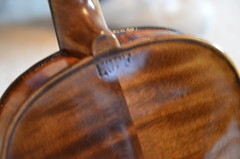 |
| The Hopf Mark |
 |
| My other violin |
Back to the steel guitar and my current lessons. One of the techniques I am starting to learn bar shivers. Bar shivers is where you pick a note, let it ring and as you slide down to your next fret, vigorously over emphasize a vibrato as you slide down. The difference between vibrato and shivers is the range of movement used to achieve the effect. Many steel players use shivers like vibrato and overuse it.
Well thats it for now. Today is Sunday 27 JAN 2013 and I have a lesson today. I will write another post this evening about my lesson. I am going to try and keep up my posts 3 times a week to match my lesson schedule otherwise I will forget details to include in my posts.
Saturday, January 26, 2013
Software Tools
Christmas was awesome this year. I received Tabledit and Amazing Slowdowner and I will describe these tools.
Amazing Slowdowner
With Amazing Slowdowner you can take an audio file and slow it down 20% to 200% without losing the pitch. The audio file forats supported are MP3, AIFF, AAC/MP4 and wave files. M4P files from iTunes store are supported by Amazing Slow downer version 3.0.5 and up. Amazing Slow Downer also allows you to change the pitch in semi tones at full speed or at changed speeds. It also allows you to change pitch in cents or 1/100th of a semi tone. I have loaded songs from a CD and also from iTunes. I briefly experimented with this software and I found it to be easy to use, intuitive without needing to read the instructions or help files. Of course some of the features I will need to read up on. This software is available for Windows, Mac, iPad/iPhone and they are working on a version for the Android. I recommend this software.
Tabledit
Tabledit allows you to enter tablature and it will generate sheet music with notes. It will also do the reverse, enter notes and generate tablature. It is designed to work for any stringed instrument. Of course my interest is primarily with the pedal steel guitar. I have not figured out yet how to do bends and am reading the manual. I have found that the program allows to use the notation I am use to using. I can assign A, B, C, D, F or user defined letters on specific strings. You can also control how many steps the string is raised or lowered. It places the pedal/lever movement to the right of the fret number for the string in question.
I have added links for both of these sites. As I learn more, I will share with you what I learn. I think this is a cool program but I have a lot to learn.
Well I have caught you up to where I am at right now in January of 2013. I have finished up on learning The Last Date. I still need to relearn The Old Rugged Cross and Amazing Grace which I will do as I move on to my next song. So far this week have practiced 8 hours and have scheduled at least 3 hours for today. In my next post I will cover in more detail than my journey posts on what I am working on.
Amazing Slowdowner
With Amazing Slowdowner you can take an audio file and slow it down 20% to 200% without losing the pitch. The audio file forats supported are MP3, AIFF, AAC/MP4 and wave files. M4P files from iTunes store are supported by Amazing Slow downer version 3.0.5 and up. Amazing Slow Downer also allows you to change the pitch in semi tones at full speed or at changed speeds. It also allows you to change pitch in cents or 1/100th of a semi tone. I have loaded songs from a CD and also from iTunes. I briefly experimented with this software and I found it to be easy to use, intuitive without needing to read the instructions or help files. Of course some of the features I will need to read up on. This software is available for Windows, Mac, iPad/iPhone and they are working on a version for the Android. I recommend this software.
Tabledit
Tabledit allows you to enter tablature and it will generate sheet music with notes. It will also do the reverse, enter notes and generate tablature. It is designed to work for any stringed instrument. Of course my interest is primarily with the pedal steel guitar. I have not figured out yet how to do bends and am reading the manual. I have found that the program allows to use the notation I am use to using. I can assign A, B, C, D, F or user defined letters on specific strings. You can also control how many steps the string is raised or lowered. It places the pedal/lever movement to the right of the fret number for the string in question.
I have added links for both of these sites. As I learn more, I will share with you what I learn. I think this is a cool program but I have a lot to learn.
Well I have caught you up to where I am at right now in January of 2013. I have finished up on learning The Last Date. I still need to relearn The Old Rugged Cross and Amazing Grace which I will do as I move on to my next song. So far this week have practiced 8 hours and have scheduled at least 3 hours for today. In my next post I will cover in more detail than my journey posts on what I am working on.
Wednesday, January 23, 2013
My Journey 2009 - 2012 Part III
I am just about done bringing you up to date on my songs with a discussion of The Last Date, Aloha Oe and The Water Is Wide.
The arrangement of The Last Date that I have been learning is the longest song I have learned to date at about 6 minutes. I initially learned this song about six months ago and then forgot how to play it. So now I am relearning this song. You will not be surprised that it has second octave work too. There is nothing too technically difficult with this song, yet the second octave work has been giving me problems. There are three sections to the second octave part and each one is different for the listener, however, they are similar enough that to me as the player they play the same. I get confused as to where I am and where the changes are from one section to the next. It is funny how simple can be so hard. I have been practicing two sections concentrating on the difference between the two and making little mnemonics up to help me remember the difference. The next thing I am doing is repeating just these two sections in my practice session. It gets old pretty fast but it is the only way I know to conquer the problem. I break my practice session up going over other songs I know and reinforce retention of those songs. I am tired of forgetting and having to relearn songs. Initially, I focus on the mechanics of the sections i.e. what fret and what strings, slides and slurs and bends. Last night my familiarity with the two sections was improving and I started focusing on precision. I practice each section very slowly and when I move from one fret to the next I listen to the pitch. I make a note in my head whether I think I am on the fret or flat or sharp. I then stop and visually check my tone bar position and confirm what I think. I then start over again and repeat the process adding a new chord. As I am playing if I hear the precision is off, I stop visually check and start over again. The other issue I am having at the moment is my left hand position. As I hold the bar on the strings, I notice my pinky finger is raised off the strings. I am trying to break that habit. I do the same as I did when training my right hand to stay at the pickups. I play songs I already know well and when I notice my finger raised off the strings, I stop and start over. This is going to take a while. Back to last date. In the second octave there is a slur that starts with picking at the 15th fret, sliding down to the 13th fret, bend and slide to the 20th fret while picking two adjacent strings lightly maintaining sustain of the other strings that were initially picked at the 15th fret. What I need to work on is my timing with this move as I am losing my sustain. IMHO I think the sustain is more difficult to maintain in the second octave and this is where precision will help. Not just precision of being in tune but the timing and technique I use. Maybe I am not understanding my problem too. I spent three hours last night just on these two sections. Hopefully, by the time I go my next lesson, I will have these sections down and can move on to finishing this song up.
The next song I learned was Aloha Oe. Actually, this is relearning this song as this was the first song I learned when I was learning the lap steel guitar as a child. A little background on this trip down memory lane. A friend of mine when we first met, we would chat about life in general, the Seahawks, politics and such over a beer. One time it came up in conversation I was learning the steel guitar. He told me that he took lap steel guitar as a kid. Come to find out, he went to the Honolulu Conservatory of Music in Tacoma at the same time I was going to the same Conservatory in Puyallup just 10 miles away! We had a few laughs as we had the same instructor. I would tease him about playing again to which he always declined. We both compared notes and how Aloha Oe was the first song we learned. I decided to go out and learn this song again, record it and give it to him. Now, In a previous post I discussed approaches to learning the pedal steel guitar and I recommended an instructor over CD's or DVD's. This recommendation is based in part to my personal experience. After I initially learned The Last Date, I found Aloha Oe at onlinelessonsvideo.com and I will post a link. Dave Anderson is the instructor and the song comes with a DVD and pdf file of the tablature. It is a good quality production but it is just a vanilla arrangement of the song. I think this is done to teach basic concepts and as you learn you can dress the song up as you see fit. The second song I bought from Dave Anderson is The Water is Wide and again comes with DVD and tablature. Easy to follow. I have talked with my instructor about changing the arrangements of both songs a bit and we will do that in the near future. Even with the high quality of these songs by Dave Anderson, I still believe a live instructor is the best way to go. Not all learning material is easy to read or learn. Just because you are a good steel player does not necessarily make you a good instructor.
In my next post, I will discuss two Christmas gifts I received this year. The Amazing slowdowner and Tabledit.
The arrangement of The Last Date that I have been learning is the longest song I have learned to date at about 6 minutes. I initially learned this song about six months ago and then forgot how to play it. So now I am relearning this song. You will not be surprised that it has second octave work too. There is nothing too technically difficult with this song, yet the second octave work has been giving me problems. There are three sections to the second octave part and each one is different for the listener, however, they are similar enough that to me as the player they play the same. I get confused as to where I am and where the changes are from one section to the next. It is funny how simple can be so hard. I have been practicing two sections concentrating on the difference between the two and making little mnemonics up to help me remember the difference. The next thing I am doing is repeating just these two sections in my practice session. It gets old pretty fast but it is the only way I know to conquer the problem. I break my practice session up going over other songs I know and reinforce retention of those songs. I am tired of forgetting and having to relearn songs. Initially, I focus on the mechanics of the sections i.e. what fret and what strings, slides and slurs and bends. Last night my familiarity with the two sections was improving and I started focusing on precision. I practice each section very slowly and when I move from one fret to the next I listen to the pitch. I make a note in my head whether I think I am on the fret or flat or sharp. I then stop and visually check my tone bar position and confirm what I think. I then start over again and repeat the process adding a new chord. As I am playing if I hear the precision is off, I stop visually check and start over again. The other issue I am having at the moment is my left hand position. As I hold the bar on the strings, I notice my pinky finger is raised off the strings. I am trying to break that habit. I do the same as I did when training my right hand to stay at the pickups. I play songs I already know well and when I notice my finger raised off the strings, I stop and start over. This is going to take a while. Back to last date. In the second octave there is a slur that starts with picking at the 15th fret, sliding down to the 13th fret, bend and slide to the 20th fret while picking two adjacent strings lightly maintaining sustain of the other strings that were initially picked at the 15th fret. What I need to work on is my timing with this move as I am losing my sustain. IMHO I think the sustain is more difficult to maintain in the second octave and this is where precision will help. Not just precision of being in tune but the timing and technique I use. Maybe I am not understanding my problem too. I spent three hours last night just on these two sections. Hopefully, by the time I go my next lesson, I will have these sections down and can move on to finishing this song up.
The next song I learned was Aloha Oe. Actually, this is relearning this song as this was the first song I learned when I was learning the lap steel guitar as a child. A little background on this trip down memory lane. A friend of mine when we first met, we would chat about life in general, the Seahawks, politics and such over a beer. One time it came up in conversation I was learning the steel guitar. He told me that he took lap steel guitar as a kid. Come to find out, he went to the Honolulu Conservatory of Music in Tacoma at the same time I was going to the same Conservatory in Puyallup just 10 miles away! We had a few laughs as we had the same instructor. I would tease him about playing again to which he always declined. We both compared notes and how Aloha Oe was the first song we learned. I decided to go out and learn this song again, record it and give it to him. Now, In a previous post I discussed approaches to learning the pedal steel guitar and I recommended an instructor over CD's or DVD's. This recommendation is based in part to my personal experience. After I initially learned The Last Date, I found Aloha Oe at onlinelessonsvideo.com and I will post a link. Dave Anderson is the instructor and the song comes with a DVD and pdf file of the tablature. It is a good quality production but it is just a vanilla arrangement of the song. I think this is done to teach basic concepts and as you learn you can dress the song up as you see fit. The second song I bought from Dave Anderson is The Water is Wide and again comes with DVD and tablature. Easy to follow. I have talked with my instructor about changing the arrangements of both songs a bit and we will do that in the near future. Even with the high quality of these songs by Dave Anderson, I still believe a live instructor is the best way to go. Not all learning material is easy to read or learn. Just because you are a good steel player does not necessarily make you a good instructor.
In my next post, I will discuss two Christmas gifts I received this year. The Amazing slowdowner and Tabledit.
Sunday, January 20, 2013
My Journey 2009 - 2012 Part II
The next part of my journey was to have me learning We Could, Amazing Grace and The Old Rugged Cross.
The next song was We Could. When I was at TSGA and talking with other experienced players, I mentioned that I was starting to learn We Could the response was usually how hard this song was especially for a beginner. I began to ask questions of these experienced players and relayed some of my learning experiences. In retrospect, this is a hard song for a beginner, especially in the arrangement my instructor had for me. There are slides that cover as much as 14 frets with pedal and lever movements while maintaining sustain with only the initial chord picking. There was also the 2nd octave part requiring precision as well as sustain. After several weeks of learning this song, my instructor told me that the purpose in teaching me this song was two fold. First, helping me continue the development of techniques that would make me a better steel player and he wanted to see in his words "if you could fly an F-18." What I took from this was he was testing how far I could take the instruction he was giving and apply it. We began talking about the overall approach he was taking and he told me that as a beginning student, I do not know what is hard and what is not. There are steel players with a lot of experience who do not attempt some of the techniques he is teaching me. As an example he pointed out that unlike many of the steel players the steel guitar is my first instrument. Many players learn the guitar and transition to the steel guitar. With a guitar, for the most part you pick each note. With the steel guitar it is designed with slides, slurs and bends which give it the sound. Also not many players play the 2nd octave, with frets so close together it is not easy to consistently maintain your precision without much practice and is easy to wreck. By teaching me 2nd octave work early on improves my precision especially in the 1st octave. Also by teaching me sustain early on I am able to play a style that not many players cannot. I must say this discussion does not apply to pro players for they could not be where they are without these techniques. However, us mere mortals have these techniques to conquer. Next, I would face a journey that all of us must face at some point in our lives.
In May of 2010, my father was diagnosed with stage 4 lung cancer. My life would change for the next two years while caring for my father and preparing for the inevitable. I refused to take his daily life away from him, let him do what he could. When he asked for help, I was there regardless of what was asked of me. My girlfriend was very supportive and right there each and every step of the way even though it meant less time for us. I took Dad to his chemo appointments and went with him when he saw his oncologist. At one point the chemo was no longer effective, the doctor offered an experimental drug with no guarantee of how successful it would be. Dad took the option and it was more successful than even the doctor could have imagined. However, by August of 2011 even this drug was no longer effective. The doctor gave Dad until maybe Thanksgiving. We were fortunate in that we not only had Dad through Thanksgiving but also we had him at Christmas. I saw how strong his faith and belief in the Lord was and I do not think I could be as strong as I saw him be. I saw him whither away from a healthy man of 5' 11" and 220 pounds to less than 140 pounds when he passed away. Even though he was in pain and in the end the morphine did very little, he kept his sense of humor and his wits about him. After he passed away February 3rd 2012 and we were helping mom go through the paperwork, we found sticky tabs Dad had left giving instructions and points of contact information. He did everything to make it easy on Mom and us after he was gone.
Dad was a WWII veteran and was assigned to the 19th Bomber Group, 435th bombardment squadron, better known as the Kangaroo Squadron. He was a gunner and gunnery instructor. He was stationed on Okinawa when the war ended. For 65 years he was married to the same woman, a feat not achieved in todays world very often. He raised three children and all three graduated from college. He was very active with the veterans and the loved him. As veterans, we have a common thread through all of us love of country and when one falls we are all diminished. It is very hard to write this part of my post as I love, respect and admire the man I miss so much. This lead to my next song selection.
After Dad was diagnosed with cancer, I asked my instructor to teach me two songs. Amazing Grace and The Old Rugged Cross. Both songs my parents loved. The arrangement of Amazing grace my instructor taught me had 2nd octave work as well as an entire verse in harmonics. Harmonics came easy for me and when a friend told me his grandfather had been playing for 30 years and does not attempt an entire verse in harmonics and told me that for me to accomplish that was impressive, that made me feel pretty good. As soon as I learned Amazing Grace, I pushed on to The Old Rugged Cross.
In the arrangement of the Old Rugged Cross my instructor kept 2nd octave in and added levers I had not used before, specifically the G lever or RKL. Overall, I rushed learning these songs and was not able to Master them sufficiently to play at my Dad's funeral service.
In my next post I will cover The Last Date and Christmas 2012. After this next post, I will be able to report on a more regular basis my learning as I go.
The next song was We Could. When I was at TSGA and talking with other experienced players, I mentioned that I was starting to learn We Could the response was usually how hard this song was especially for a beginner. I began to ask questions of these experienced players and relayed some of my learning experiences. In retrospect, this is a hard song for a beginner, especially in the arrangement my instructor had for me. There are slides that cover as much as 14 frets with pedal and lever movements while maintaining sustain with only the initial chord picking. There was also the 2nd octave part requiring precision as well as sustain. After several weeks of learning this song, my instructor told me that the purpose in teaching me this song was two fold. First, helping me continue the development of techniques that would make me a better steel player and he wanted to see in his words "if you could fly an F-18." What I took from this was he was testing how far I could take the instruction he was giving and apply it. We began talking about the overall approach he was taking and he told me that as a beginning student, I do not know what is hard and what is not. There are steel players with a lot of experience who do not attempt some of the techniques he is teaching me. As an example he pointed out that unlike many of the steel players the steel guitar is my first instrument. Many players learn the guitar and transition to the steel guitar. With a guitar, for the most part you pick each note. With the steel guitar it is designed with slides, slurs and bends which give it the sound. Also not many players play the 2nd octave, with frets so close together it is not easy to consistently maintain your precision without much practice and is easy to wreck. By teaching me 2nd octave work early on improves my precision especially in the 1st octave. Also by teaching me sustain early on I am able to play a style that not many players cannot. I must say this discussion does not apply to pro players for they could not be where they are without these techniques. However, us mere mortals have these techniques to conquer. Next, I would face a journey that all of us must face at some point in our lives.
In May of 2010, my father was diagnosed with stage 4 lung cancer. My life would change for the next two years while caring for my father and preparing for the inevitable. I refused to take his daily life away from him, let him do what he could. When he asked for help, I was there regardless of what was asked of me. My girlfriend was very supportive and right there each and every step of the way even though it meant less time for us. I took Dad to his chemo appointments and went with him when he saw his oncologist. At one point the chemo was no longer effective, the doctor offered an experimental drug with no guarantee of how successful it would be. Dad took the option and it was more successful than even the doctor could have imagined. However, by August of 2011 even this drug was no longer effective. The doctor gave Dad until maybe Thanksgiving. We were fortunate in that we not only had Dad through Thanksgiving but also we had him at Christmas. I saw how strong his faith and belief in the Lord was and I do not think I could be as strong as I saw him be. I saw him whither away from a healthy man of 5' 11" and 220 pounds to less than 140 pounds when he passed away. Even though he was in pain and in the end the morphine did very little, he kept his sense of humor and his wits about him. After he passed away February 3rd 2012 and we were helping mom go through the paperwork, we found sticky tabs Dad had left giving instructions and points of contact information. He did everything to make it easy on Mom and us after he was gone.
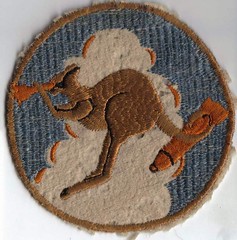 |
| 435th Bomb Squadron Patch |
Dad was a WWII veteran and was assigned to the 19th Bomber Group, 435th bombardment squadron, better known as the Kangaroo Squadron. He was a gunner and gunnery instructor. He was stationed on Okinawa when the war ended. For 65 years he was married to the same woman, a feat not achieved in todays world very often. He raised three children and all three graduated from college. He was very active with the veterans and the loved him. As veterans, we have a common thread through all of us love of country and when one falls we are all diminished. It is very hard to write this part of my post as I love, respect and admire the man I miss so much. This lead to my next song selection.
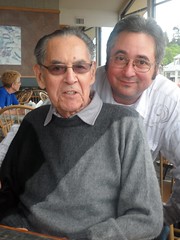 |
| Charles S Sicade Jr (left) Aug 31, 1924 - Feb 3 2012 |
After Dad was diagnosed with cancer, I asked my instructor to teach me two songs. Amazing Grace and The Old Rugged Cross. Both songs my parents loved. The arrangement of Amazing grace my instructor taught me had 2nd octave work as well as an entire verse in harmonics. Harmonics came easy for me and when a friend told me his grandfather had been playing for 30 years and does not attempt an entire verse in harmonics and told me that for me to accomplish that was impressive, that made me feel pretty good. As soon as I learned Amazing Grace, I pushed on to The Old Rugged Cross.
In the arrangement of the Old Rugged Cross my instructor kept 2nd octave in and added levers I had not used before, specifically the G lever or RKL. Overall, I rushed learning these songs and was not able to Master them sufficiently to play at my Dad's funeral service.
In my next post I will cover The Last Date and Christmas 2012. After this next post, I will be able to report on a more regular basis my learning as I go.
My Journey 2009 - 2012 Part I
I will wrap up my introductory posts by summarizing my journey over the last three years and then my follow on posts can chronicle what I am doing as I do it.
My first lesson was in November of 2009 using my Carter. The first lesson was an introduction to the guitar. How to setup the guitar and get it out of the case without killing the guitar or myself. Next was sitting behind the guitar. Using the Jeff Newman approach and center your body behind the 15th fret. This was not comfortable for me and I think if you look at my pics you will see me centered on the 12th fret. Works for me - at least for now. I also learned how to wear the picks and how to bend them properly for a good fit. I also learned the picking patterns strings 3-4-5, 4-5-6, 5-6-8, 6-8-10. My lesson for that night was palm blocking picking 4-5-6 and palm blocking each string. My instructor wanted me picking them slowly and not worry about speed. I needed to develop the muscle memory. I did not bother telling my instructor that this would not be a problem since I am still counting strings to find the 4th string! I went home and practiced trying to pick 4-5-6 palm blocking. I was hitting the wrong string, getting my pick caught in the strings. Sticking with it, I soon was able to pick the right string consistently and palm block.
At my second lesson, my instructor began to teach me Steel Guitar Rag. No pedals or levers to worry about! I learned hammer on and hammer off technique. Hammer on is where you pick an open string and while the string is ringing put the tone bar down on the string. Hammer on is the opposite pick a string with the tone bar on a fret and while the string is ringing lift the tone bar off the string. I also learned how to hold the tone bar when picking a single string so the tone bar is only against the single string being picked.
Over the next several weeks we went through the song from start to finish. I brought my cassette recorder to record each lesson. I still struggled with picking the correct string combinations and getting my picks tangeled with a string I did not want to pick. Right hand position was a problem as it drifted south away from the pickups. Left hand position was a problem too as my precision was not there. When I look at the tone bar, I would think I was on the fret and I would actually be flat. At the lower frets like the third fret, I would need to position the tone bar so I could not see the fret itself and I would physically move my body so I was lined up behind the tone bar so I could see if I was on the fret or not. Once I was on the fret, I would pick the chord repeatedly and try to memorize the pitch. The higher the fret the more pronounced the illusion of where the tone bar appeared to be versus where it actually was.
After I learned the mechanics of Steel Guitar Rag, my instructor started teaching me Blue Hawaii. At this point in my education I did not realize how badly I was playing Steel Guitar Rag and this would not become evident for about a year and I will come back to this in another post. Blue Hawaii was the first song where I would be using pedals and levers in a song. Albeit A and B pedals and the F and D levers. How these pedals and levers work is not magical. The pedals and levers are spring loaded. Press down on a pedal and it changes the pitch of the string. Release the pedal and the string returns to the original pitch. Same thing occurs with the levers. Your left leg is positioned between the F and D levers. I have a Day setup so My second pedal is B and the D lever is the left most lever. This means B and D are lined up on the same side of your leg. Likewise the A and F are lined up on the right side of your leg. Makes it easy to press B pedal and D lever or A and F. I had to learn how to use the pedals and levers properly and not slam into them.
Additionally I had to continue to focus on precision of my tone bar, left hand position as I was still drifting south off the pickups. After I learned the mechanics of the song my instructor focused on developing timing, getting into the "groove". He had me use a metronome. This was the most frustrating things for me to learn. I was having a difficult enough time focusing on right hand technique, left hand technique, precision, remembering the song and now he wanted me to play to the metronome! To many of you it may seem a simple matter, but to me I struggled with timing and still do to a degree. Eventually I started getting the concept down. With practice, as with everything else, it gets easier in time.
The next song I was to learn was Sleepwalk by Santo and Johnny. The first technique I had to learn was finger harmonics. For those of you who do not know this technique it goes as follows:
1. Place your tone bar on a fret. For our purposes lets use the 3rd fret.
2. Now you get to hold your picking hand in a weird contorted position. With your picking hand in front of you, hold your thumb in the 9 o'clock position with your forearm at a 30 degree (approximately) to your body. Your ring finger will be at the 9 o'clock position. Your middle finger will be pointing straight back at your body. The proper position will have the middle finger parallel the fret markers.
3. With tone bar at the 3rd fret, we need to pick one octave up at the 15th fret. Pick the 4th string with thumb and middle finger at the same time. The image below shows me at the 17th fret.
Do not be surprised if you get a "thunk" sound the first few times you do this. What you will need to do is ensure your tone bar is properly placed. Just because you are exactly on the 3rd fret does not ensure a harmonic. If you are tuned slightly flat or sharp you will need to adjust your placement of the tone bar. Also, in conjunction with tone bar placement, you may pick slightly flat or sharp around the 15th fret to find the "sweet spot" of your guitar. Some guitars are more forgiving than others.
Tip:
After you get the basic technique down for harmonics, here is an exercise that helped me. Place your tone bar at the 5th fret. Pick your harmonics at the 15th fret, picking all ten strings. I start at the 10th string and work my way up to the 1st string and then back down. Now, leaving your tone bar at the 5th fret, move down to the 12th fret and pick the harmonic there repeating the 10 string process. Do you notice it is a little harder to hit the harmonic? Once you get this down, repeat the process leaving the tone bar at the 5th fret and move your picking hand to the 10th fret and pick all ten strings up and down. Finally, leaving the tone bar at the 5th fret, move your picking hand to the 8th fret and pick the harmonic on all 10 strings up and back down. I promise you that there is a harmonic at each of these positions. What this exercise will do for you is improve your precision. It is very difficult to get the harmonic at the 8th fret. Once you get it down, then your harmonic at the 15th fret will be almost effortless. This is what I mean by paying attention to details. This will take hours upon hours of practice. I do not know why, I picked this harmonics up pretty quickly. Maybe you will and maybe you will struggle with it. If you do this exercise, I would like to hear from you on your success or frustration with it.
Once I had the harmonics down, I learned the entire song sleepwalk using the harmonic pick and slide. Maintaining sustain during a slide with a harmonic is difficult in my opinion. At first it was dying before I could complete my slide. Again, I practiced this one move hour upon hour until I started getting it. To this day two years later, I still practice harmonics daily.
In my next post, I will cover my next group of songs I learned "The Old Rugged Cross", "Amazing Grace" and "We Could". I will also discuss a personal tragedy for me and how it impacted me musically.
My first lesson was in November of 2009 using my Carter. The first lesson was an introduction to the guitar. How to setup the guitar and get it out of the case without killing the guitar or myself. Next was sitting behind the guitar. Using the Jeff Newman approach and center your body behind the 15th fret. This was not comfortable for me and I think if you look at my pics you will see me centered on the 12th fret. Works for me - at least for now. I also learned how to wear the picks and how to bend them properly for a good fit. I also learned the picking patterns strings 3-4-5, 4-5-6, 5-6-8, 6-8-10. My lesson for that night was palm blocking picking 4-5-6 and palm blocking each string. My instructor wanted me picking them slowly and not worry about speed. I needed to develop the muscle memory. I did not bother telling my instructor that this would not be a problem since I am still counting strings to find the 4th string! I went home and practiced trying to pick 4-5-6 palm blocking. I was hitting the wrong string, getting my pick caught in the strings. Sticking with it, I soon was able to pick the right string consistently and palm block.
At my second lesson, my instructor began to teach me Steel Guitar Rag. No pedals or levers to worry about! I learned hammer on and hammer off technique. Hammer on is where you pick an open string and while the string is ringing put the tone bar down on the string. Hammer on is the opposite pick a string with the tone bar on a fret and while the string is ringing lift the tone bar off the string. I also learned how to hold the tone bar when picking a single string so the tone bar is only against the single string being picked.
Over the next several weeks we went through the song from start to finish. I brought my cassette recorder to record each lesson. I still struggled with picking the correct string combinations and getting my picks tangeled with a string I did not want to pick. Right hand position was a problem as it drifted south away from the pickups. Left hand position was a problem too as my precision was not there. When I look at the tone bar, I would think I was on the fret and I would actually be flat. At the lower frets like the third fret, I would need to position the tone bar so I could not see the fret itself and I would physically move my body so I was lined up behind the tone bar so I could see if I was on the fret or not. Once I was on the fret, I would pick the chord repeatedly and try to memorize the pitch. The higher the fret the more pronounced the illusion of where the tone bar appeared to be versus where it actually was.
After I learned the mechanics of Steel Guitar Rag, my instructor started teaching me Blue Hawaii. At this point in my education I did not realize how badly I was playing Steel Guitar Rag and this would not become evident for about a year and I will come back to this in another post. Blue Hawaii was the first song where I would be using pedals and levers in a song. Albeit A and B pedals and the F and D levers. How these pedals and levers work is not magical. The pedals and levers are spring loaded. Press down on a pedal and it changes the pitch of the string. Release the pedal and the string returns to the original pitch. Same thing occurs with the levers. Your left leg is positioned between the F and D levers. I have a Day setup so My second pedal is B and the D lever is the left most lever. This means B and D are lined up on the same side of your leg. Likewise the A and F are lined up on the right side of your leg. Makes it easy to press B pedal and D lever or A and F. I had to learn how to use the pedals and levers properly and not slam into them.
Additionally I had to continue to focus on precision of my tone bar, left hand position as I was still drifting south off the pickups. After I learned the mechanics of the song my instructor focused on developing timing, getting into the "groove". He had me use a metronome. This was the most frustrating things for me to learn. I was having a difficult enough time focusing on right hand technique, left hand technique, precision, remembering the song and now he wanted me to play to the metronome! To many of you it may seem a simple matter, but to me I struggled with timing and still do to a degree. Eventually I started getting the concept down. With practice, as with everything else, it gets easier in time.
The next song I was to learn was Sleepwalk by Santo and Johnny. The first technique I had to learn was finger harmonics. For those of you who do not know this technique it goes as follows:
1. Place your tone bar on a fret. For our purposes lets use the 3rd fret.
2. Now you get to hold your picking hand in a weird contorted position. With your picking hand in front of you, hold your thumb in the 9 o'clock position with your forearm at a 30 degree (approximately) to your body. Your ring finger will be at the 9 o'clock position. Your middle finger will be pointing straight back at your body. The proper position will have the middle finger parallel the fret markers.
3. With tone bar at the 3rd fret, we need to pick one octave up at the 15th fret. Pick the 4th string with thumb and middle finger at the same time. The image below shows me at the 17th fret.
Do not be surprised if you get a "thunk" sound the first few times you do this. What you will need to do is ensure your tone bar is properly placed. Just because you are exactly on the 3rd fret does not ensure a harmonic. If you are tuned slightly flat or sharp you will need to adjust your placement of the tone bar. Also, in conjunction with tone bar placement, you may pick slightly flat or sharp around the 15th fret to find the "sweet spot" of your guitar. Some guitars are more forgiving than others.
Tip:
After you get the basic technique down for harmonics, here is an exercise that helped me. Place your tone bar at the 5th fret. Pick your harmonics at the 15th fret, picking all ten strings. I start at the 10th string and work my way up to the 1st string and then back down. Now, leaving your tone bar at the 5th fret, move down to the 12th fret and pick the harmonic there repeating the 10 string process. Do you notice it is a little harder to hit the harmonic? Once you get this down, repeat the process leaving the tone bar at the 5th fret and move your picking hand to the 10th fret and pick all ten strings up and down. Finally, leaving the tone bar at the 5th fret, move your picking hand to the 8th fret and pick the harmonic on all 10 strings up and back down. I promise you that there is a harmonic at each of these positions. What this exercise will do for you is improve your precision. It is very difficult to get the harmonic at the 8th fret. Once you get it down, then your harmonic at the 15th fret will be almost effortless. This is what I mean by paying attention to details. This will take hours upon hours of practice. I do not know why, I picked this harmonics up pretty quickly. Maybe you will and maybe you will struggle with it. If you do this exercise, I would like to hear from you on your success or frustration with it.
Once I had the harmonics down, I learned the entire song sleepwalk using the harmonic pick and slide. Maintaining sustain during a slide with a harmonic is difficult in my opinion. At first it was dying before I could complete my slide. Again, I practiced this one move hour upon hour until I started getting it. To this day two years later, I still practice harmonics daily.
In my next post, I will cover my next group of songs I learned "The Old Rugged Cross", "Amazing Grace" and "We Could". I will also discuss a personal tragedy for me and how it impacted me musically.
Sunday, January 6, 2013
My Studio
I have an in home studio where I practice and record. It is not a professional studio by a long shot but I have decent equipment. I have an L shaped table with no storage where my iMac and Presonus sit. I also have my monitors on the table. A few months back I bought a Gator box and had my Presonus mounted in the Gator box. My Digital Stereo amplifier is mounted in a box of its own along with the effects processor. Since these two units are 2u, and 1u respectively, and I mainly use this amp for recording, I am going to mount them inside the Gator box. Saves some room. I am going to replace the L shaped table with a desk/hutch combination which will give me storage and reduce the clutter. I will also be able to get rid of the file drawer I currently use to sit my Digital amp on. Below are some before and after pics. Any comments or suggestions are welcome. All I have left to do is mount the amplifier and effects processor. Here are some before and after pictures.
Before
What a mess!
In Progress
After
Plenty of storage now
The Reward! "Jack Daniels if you please."
I still have to move my digital stereo amplifier into my Gator box but for the most part I am done. Now it is time to get back on track. In my next post I will summarize my Journey from 2009 to 2012 so I can start chronicling my journey in detail forward.
Before
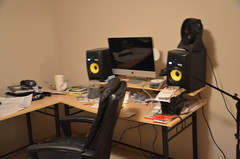 |
| My Studio Before |
What a mess!
 |
| My Studio Before |
 |
| Music Studio |
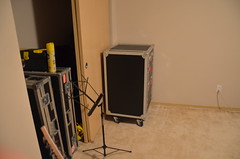 |
| Music Studio Storage Space |
In Progress
 |
| The Transformation Begins |
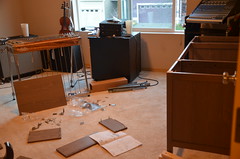 |
| In Work |
After
 |
| No Change Here |
 |
| Wide Open Spaces! |
 |
| My Corner |
 |
| New Desk With Hutch |
Plenty of storage now
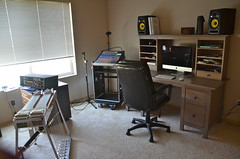 |
| The Overall Look |
 |
| My Music Studio -- Presonus 16.4.2 |
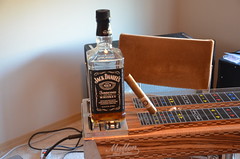 |
| Reward! |
I still have to move my digital stereo amplifier into my Gator box but for the most part I am done. Now it is time to get back on track. In my next post I will summarize my Journey from 2009 to 2012 so I can start chronicling my journey in detail forward.
Buying a Pedal Steel Guitar -- Part I
In this post I cover the basics of what to consider when buying a pedal steel guitar. For more detailed information on considerations follow this link to Part II Buying A Pedal Steel Guitar -- Part II
Wednesday, January 2, 2013
Approaches to Learning the Pedal Steel Guitar
I describe some different approaches to learning the pedal steel guitar and their advantages and disadvantages. I also give tips that have helped in my journey learning the pedal steel guitar.
Subscribe to:
Posts (Atom)
